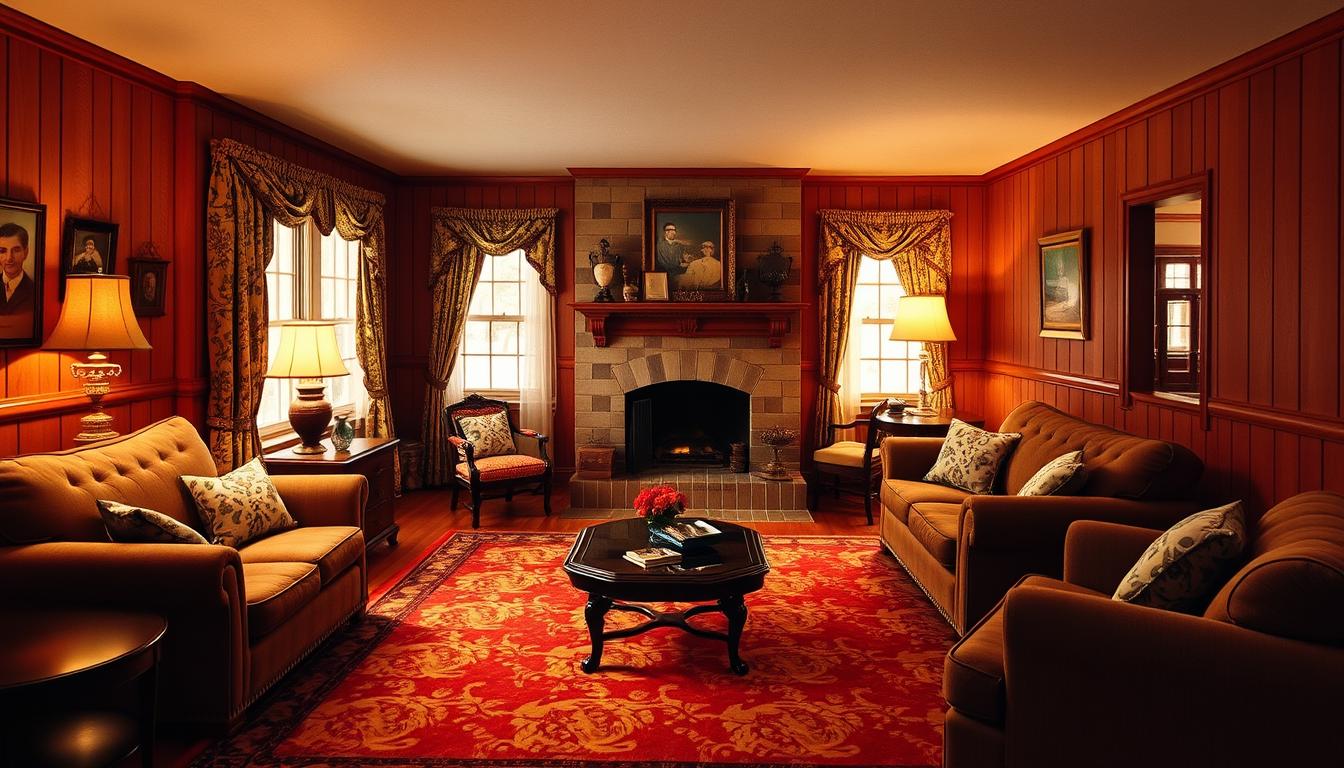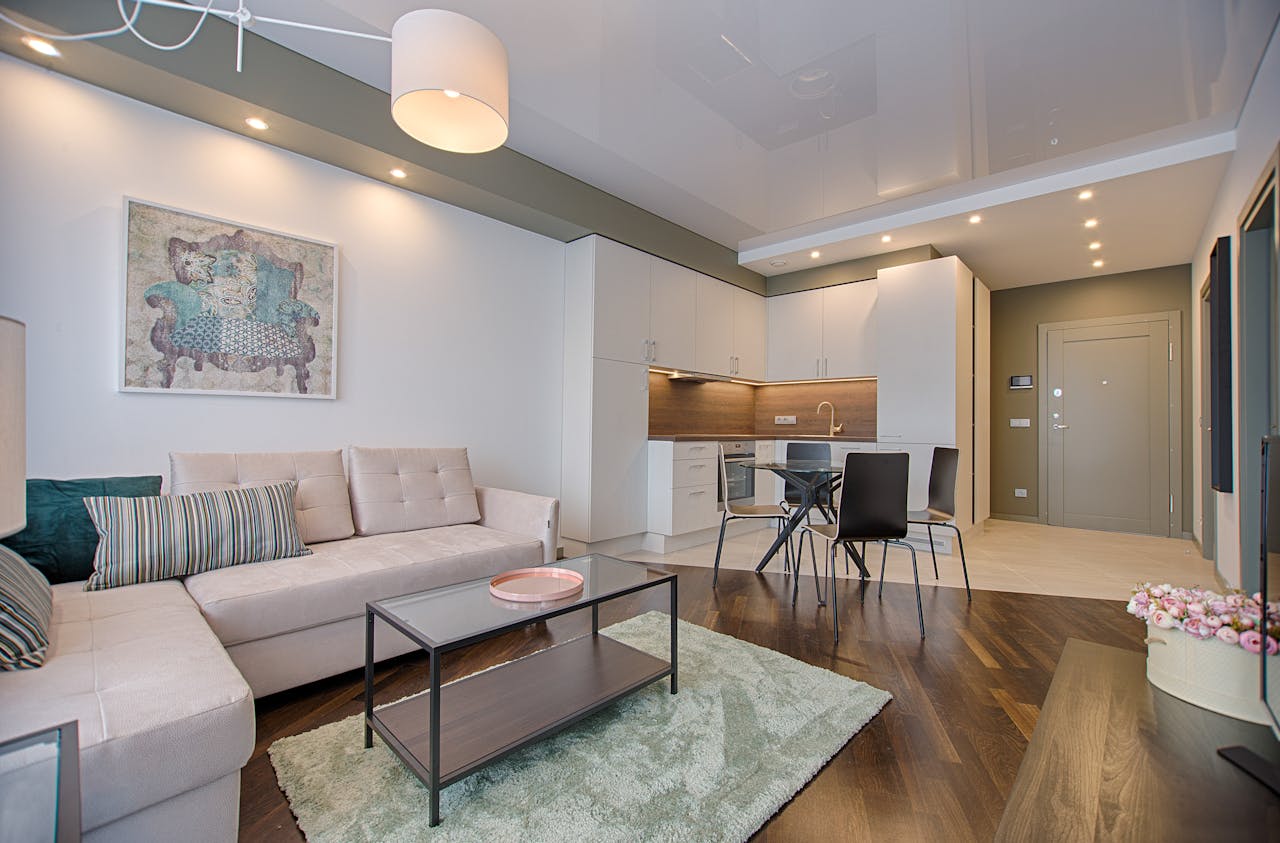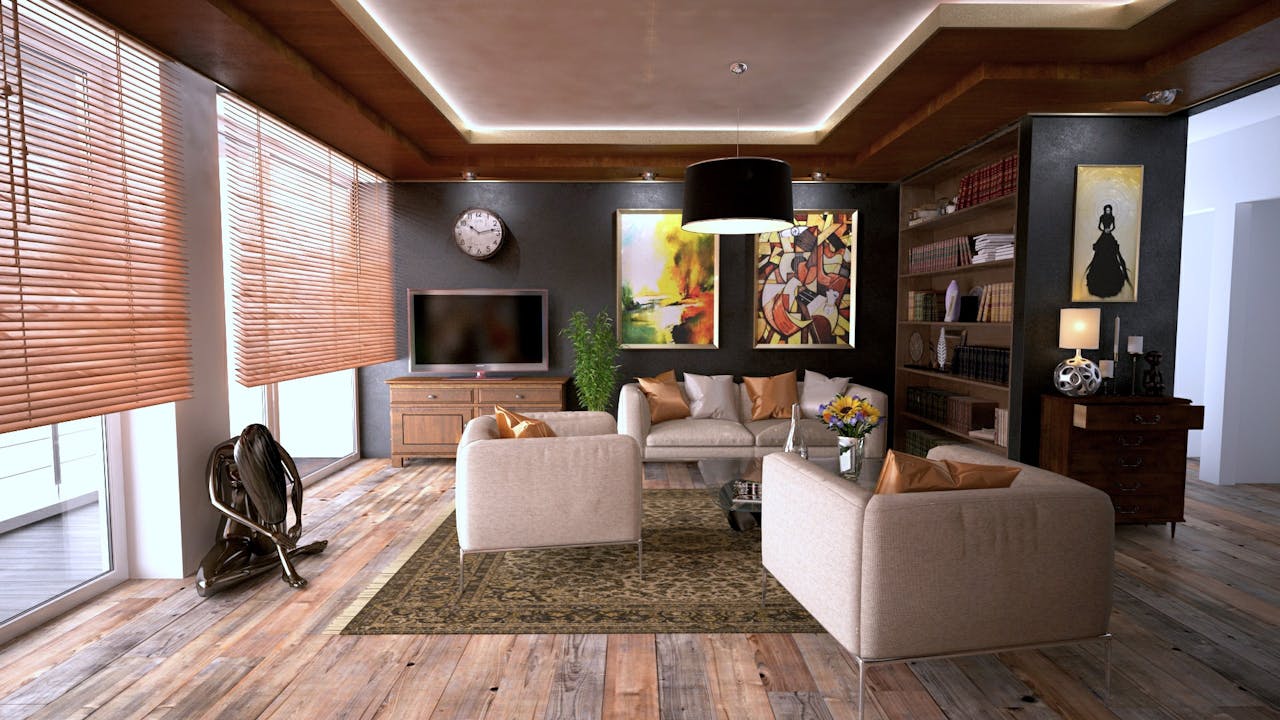Between 1908 and 1940, Sears, Roebuck and Co. sold over 75,000 homes through their catalog. This changed how people lived in America. These Sears homes were more than just buildings; they were complete living solutions, including their interior design.
We look into how these homes, from Craftsman bungalows to Colonial Revivals, were made to be both useful and beautiful. Their interior design showed off the architectural styles of their time. This gives us a special look into the past.
Key Takeaways
- Over 75,000 Sears homes were sold between 1908 and 1940.
- Sears homes represented a complete living solution, including interior decor.
- The designs ranged from Craftsman bungalows to Colonial Revivals.
- These homes were marketed as functional and aesthetically pleasing.
- The interior design reflected the architectural styles of their era.
The History of Sears Homes and Their Interiors
In 1908, Sears, Roebuck and Co. started selling prefabricated homes. This made good homes affordable for many Americans. It changed the housing market and left a mark on American architecture.
At the time, prefabricated homes were a big deal. They were a smart way to meet the housing needs of a growing population. Sears homes were sold through catalogs, letting people pick from various designs and features.
The Rise of Prefabricated Homes
Prefabricated homes quickly became popular because they were affordable and easy to build. People could build them themselves or hire a local contractor. The homes came with pre-cut lumber and other materials from the factory.
This method saved time and money. It made owning a home possible for more people. Sears homes showed how innovation can meet market needs.
Sears and the American Dream
Sears homes were seen as a part of the American Dream. They were a symbol of homeownership for many. Sears aimed to offer quality products at good prices, matching the dreams of many families.
Sears offered homes in many styles, from simple to fancy. This let homeowners choose a home that fit their taste and neighborhood.
Architectural Styles of Sears Homes
Sears homes came in many styles, like Colonial Revival and Craftsman. They even had Modern and Art Deco designs. This variety let homeowners pick a home that matched their taste and neighborhood.
The wide range of styles made Sears homes appealing. They could fit in with different areas while still being unique.
Key Features of Sears Home Interiors
Sears homes were known for their smart designs. They used space well and were both beautiful and useful. These homes met the needs and dreams of the families who lived in them.
Open Floor Plans
One standout feature of Sears homes is their open floor plans. These designs made the homes feel bigger and more open. They were perfect for families.
Open floor plans also helped families stay connected. They made it easy to watch over kids while cooking or doing other things. This made the homes feel modern and welcoming.
Built-in Furniture Innovations
Sears homes often had built-in furniture like bookshelves and banquettes. These features added charm and served practical purposes. They provided storage and seating without taking up too much space.
The use of built-in furniture showed Sears’ innovative spirit. It showed a smart way to mix beauty and usefulness.
Unique Storage Solutions
Sears homes also had special storage solutions. They had clever closets and hidden spots for storing things. These helped keep the homes tidy.
When decorating Sears homes, it’s important to keep these original storage solutions. They added to the homes’ usefulness and made them unique.
Iconic Interior Styles Found in Sears Homes
Sears homes are known for their mix of interior design styles. These homes were affordable and had innovative designs. They showed off the popular styles of the early 20th century.
Colonial Revival Interior Design
The Colonial Revival style was common in Sears homes. It featured wooden paneling, furniture with clean lines, and traditional designs. This style honored the country’s colonial history, focusing on simplicity and usefulness.
For those wanting to renovate their Sears home, adding Colonial Revival elements can make it timeless.
Arts and Crafts Influences
Arts and Crafts influences were also seen in Sears homes. They used handcrafted furniture and natural materials like wood and stone. This style valued handiwork and the human touch in design.
When looking for decorating tips, Arts and Crafts can add warmth and character to a room.
Mid-Century Modern Touches
Some Sears homes also had Mid-Century Modern elements. These included open floor plans, large windows, and a mix of old and new materials. This style looked to the future, blending indoor and outdoor spaces.
Updating a Sears home with Mid-Century Modern touches can refresh it while keeping its original charm.
Understanding these iconic styles helps homeowners find renovation ideas and decorating tips. This way, they can keep their Sears home’s unique character while making it modern.
Popular Home Models and Their Interior Layouts
Sears, Roebuck and Co. offered many home models, each with its own style and interior design. Some models were known for their unique layouts and classic looks. Let’s look at a few popular models and what made their interiors special.
The Sears Roebuck Model
The Sears Roebuck Model was very popular for its spacious interior and practical design. It had open floor plans, which were new at the time. This allowed for easy movement and lots of natural light. The interior also had built-in furniture and clever storage, making it a hit with homeowners.
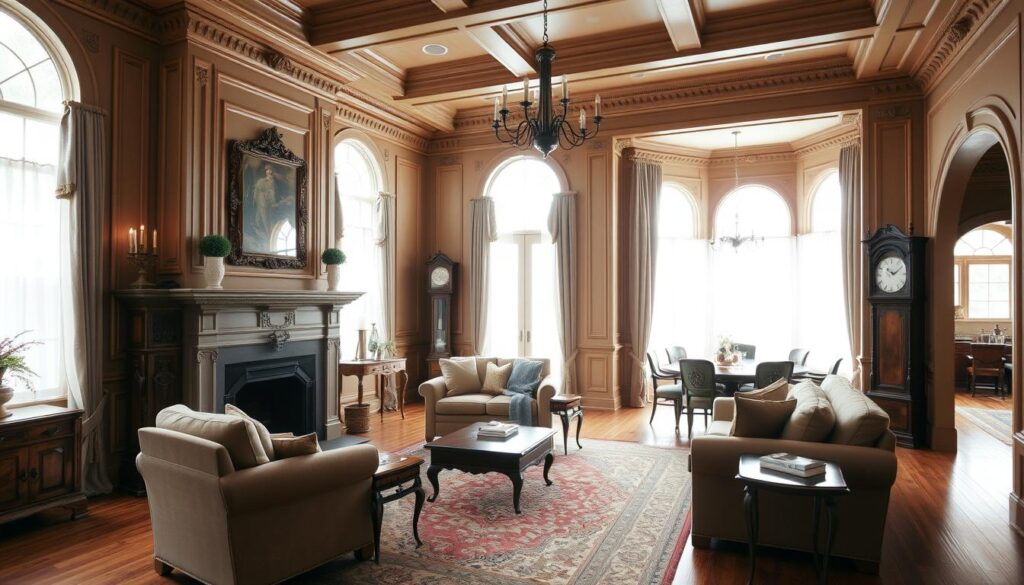
The Vallonia Design
The Vallonia Design was also very popular, known for its Arts and Crafts influences and cozy interior. Its layout focused on comfort and function, with big living areas and smart kitchen designs. Homeowners loved the model’s detail and the warmth it added to their homes.
“The Vallonia Design exemplifies the blend of form and function that Sears homes are known for.”
The Van Kleeck Home
The Van Kleeck Home had a Colonial Revival style and a classic interior design. It featured traditional elements like wood paneling and large fireplaces. This made it warm and inviting. The Van Kleeck Home showed Sears’ skill in creating beautiful and functional homes.
For more info on Sears homes and their designs, visit https://theclose.com/sears-catalog-homes/. This site has lots of info on Sears homes, including their interior layouts and architectural styles.
| Model | Interior Features | Design Style |
|---|---|---|
| Sears Roebuck Model | Open floor plans, built-in furniture | Practical, modern |
| Vallonia Design | Large living areas, efficient kitchens | Arts and Crafts |
| Van Kleeck Home | Wood paneling, large fireplaces | Colonial Revival |
The Importance of Natural Light in Sears Interiors
Natural light was key in Sears home interiors. It made the spaces look better and feel more open. Sears homes were built to let in lots of natural light, making them warm and inviting.
Windows and Skylights
Large windows and skylights were used to bring in lots of natural light. This light reached deep into the homes, lighting up even the farthest corners.
- Big windows gave great views and lots of natural light.
- Skylights brought light into the home, cutting down on the need for artificial light.
Open Spaces for Brightness
Sears homes also had open floor plans. This design made the homes feel brighter and more airy. With fewer walls, natural light could move freely around the home.
- Open floor plans helped natural light move around.
- This design also made the home feel connected and easy to move through.
Use of Reflective Surfaces
Reflective surfaces were another way to use natural light. Mirrors, light colors, and shiny surfaces were used to bounce sunlight around. This made the homes feel brighter and more welcoming.
- Mirrors were placed by windows to reflect light into the room.
- Light colors on walls and ceilings helped spread the light evenly.
These design choices made Sears homes special. They balanced function and beauty, showing off the charm of vintage home decor. The focus on natural light made these homes not just livable but also beautiful.
Interior Design Trends in Historical Context
The interior design of Sears homes, built from the 1920s to the 1940s, was shaped by the era’s social and cultural shifts. These homes’ designs reflect the tastes of their time and the broader historical context.
Evolution of Decor from the 1920s to 1940s
In the 1920s, interior design moved towards modern, streamlined styles, influenced by Art Deco. This era saw bold geometric patterns, metallics, and luxury. The Great Depression and World War II then brought a more practical, functional approach to decor.
Sears homes showed this change through built-in furniture, efficient storage, and new materials. For example, plywood made designs more flexible and affordable.
The Influence of World Events on Design Choices
World events, like economic downturns and wars, deeply affected Sears home designs. The Great Depression led to a culture of thriftiness and DIY, seen in home decor through material reuse and furniture repurposing.
World War II also shaped designs, with homes featuring patriotic colors and motifs. Material scarcity led to creative solutions in design.
How Trends Reflected Society and Culture
The interior design trends in Sears homes mirrored the era’s aesthetic tastes and societal values. Open floor plans, for instance, showed changing family and social attitudes. The use of new appliances and technologies highlighted the era’s focus on modernity and advancement.
Today, these homes offer a glimpse into the past, revealing cultural and social contexts. For those renovating or decorating Sears homes, understanding these historical trends can be a valuable resource.
Renovating and Restoring Sears Homes
Renovating a Sears home means keeping its original charm while adding modern touches. It’s key to balance old charm with new comforts. This way, the home stays true to its past but feels modern.
Tips for Maintaining Original Features
Keeping a Sears home’s original look is a big challenge. Start by checking out its features, like cabinetry and floors. Documenting these elements before you start is very important.
When fixing up old parts, use materials and methods from the home’s time. For example, choose traditional finishes for hardwood floors. This keeps the home’s era feel alive.
Modern Upgrades with Classic Appeal
Adding modern touches to a Sears home needs careful thought. For example, update the kitchen by keeping the layout but adding new appliances. This way, the kitchen looks modern but still fits the home’s style.
Another idea is to use old parts in new ways. Turn an old linen closet into a pantry or storage. This keeps the home’s charm while making it more useful.
Working with Historical Guidelines
If your Sears home is historic, there are rules for renovations. It’s important to know these rules to avoid problems.
Even without official historic status, following preservation principles is wise. This might mean talking to preservation groups or architects. They can help make sure your updates respect the home’s history.
The Future of Sears Homes in Interior Design
Sears homes are getting a new look with modern, green practices. We’re updating these homes to keep their charm but make them better for today’s needs. This means they’re more livable and efficient.
One big trend is sustainability and energy efficiency. People want to add eco-friendly stuff, save energy, and use smart tech in their Sears homes.
Sustainability and Energy Efficiency Trends
Using green materials is a big deal. We’re talking about reclaimed wood, paints that don’t harm the air, and recycled stuff for updates. Also, we’re adding energy-saving things like LED lights, solar panels, and better insulation.
| Sustainable Material | Energy Efficiency Upgrade | Cost Benefit |
|---|---|---|
| Reclaimed Wood | LED Lighting | Reduces energy consumption by up to 80% |
| Low-VOC Paints | Solar Panels | Can reduce electricity bills by up to 50% |
| Recycled Materials | Better Insulation | Lowers heating and cooling costs by up to 30% |
Integrating Smart Home Technology
Smart tech is making Sears homes modern. We’re talking about smart thermostats and voice-controlled lights. These make life easier, safer, and more energy-smart.
Smart thermostats learn your habits to save energy. Smart lights turn off when you’re not around. It’s all about saving energy.
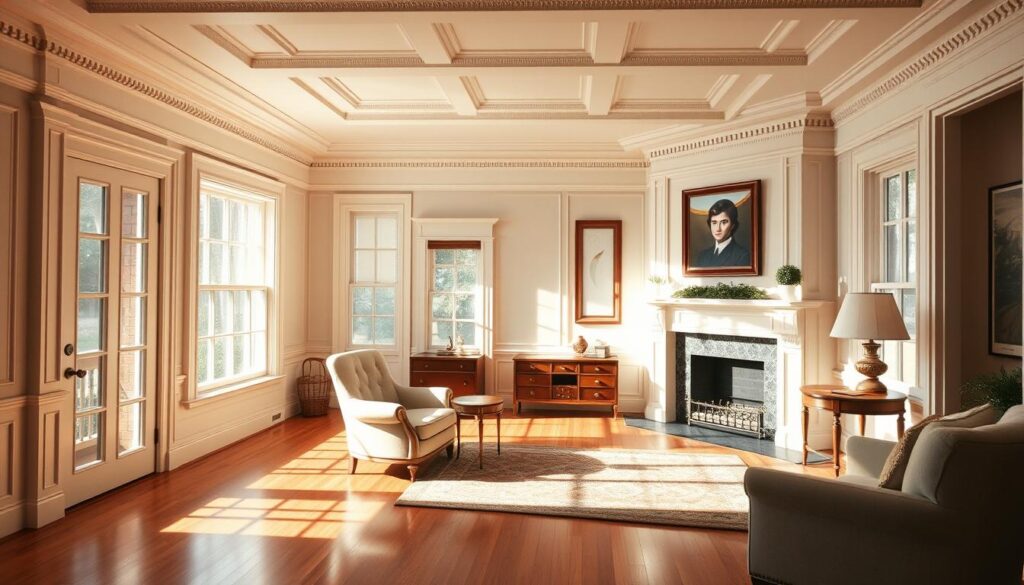
Blending Tradition with Innovation
Renovating Sears homes is a challenge. We aim to keep their charm while adding new stuff. This means keeping the old wood floors and cabinetry but adding modern tech.
This way, homeowners get the best of both worlds. They keep the Sears home’s unique feel but enjoy today’s comforts and tech.
As we keep updating Sears homes, their future looks bright. We’re focusing on green living, tech, and keeping their classic charm.
Resources for Sears Home Enthusiasts
If you love Sears homes, you’re in luck. There’s a lot of resources out there to help you. Whether you want to fix up a Sears home or get decorating tips, you’ll find what you need.
Connecting with the Community
Online groups and forums are great for Sears home fans. They let you share ideas, ask questions, and learn from others. These spaces are full of valuable info on Sears homes’ history and design.
Delving Deeper into Sears History
For a deeper dive, check out books and documentaries on Sears homes. They explore the history and architecture of these homes. You’ll learn about their past and the new ideas they brought to building.
Professional Guidance for Restoration
Need help with your Sears home? Look for decorating services that know Sears designs. They can give you advice and help keep your home’s charm while adding modern touches.

